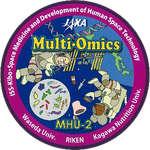This is an archive of information released in the past.
Disclaimer: It may contain broken links or outdated information. Some parts may not function in current web browsers.
*Visit https://humans-in-space.jaxa.jp/en/ for the latest information.

Experiment
- News
- Kibo Utilization Strategy
- Kibo Utilization Plan
- List of JAXA's Utilization Themes
- Experiment Facilities
- Space Environment Utilization
- Archive
Successful dietary intervention of mice using an improved MARS(Multiple Artificial-gravity Research System)under artificial 1g

Japan Aerospace Exploration Agency
RIKEN
Kagawa Nutrition University
Waseda University
【Points】
- Improved MARS successfully prevented water leakage and stabilized housing environment on the International Space Station (ISS).
- The first dietary intervention of mice using prebiotics(*) was conducted on the ISS
*Nutrients which encourage the growth of beneficial intestinal bacteria
【Background】
Japan Aerospace Exploration Agency (JAXA) developed mouse habitat cage units (HCUs) equipped with an artificial gravity-producing centrifuge, called the Multiple Artificial-gravity Research System (MARS), and conducted the first one-month mission under μg and artificial 1g in the ISS Kibo module in 2016 (the first JAXA mouse mission). The experimental platform MARS enabled to evaluate impacts of μg and artificial gravity on mice, because environmental conditions in μg and artificial 1g sections were identical except gravity (Shiba, D et al. Scientific Reports 2017).
【Summary】
The MARS underwent improvement in water leakage that happened in a μg section during the first JAXA mouse mission, and the improved MARS was used in the second JAXA mouse mission in the ISS Kibo module. Twelve mice were divided into four groups of three, with each group fed a diet either with or without prebiotics, fructo-oligosaccharide (FOS) and housed singly either at μg or artificial 1g for 30 days. Changes in mouse body weight were evaluated to examine the impact of FOS and gravity. The modified MARS showed no water leakage during the second mission. Achievement of environmentally stable MARS should open new space research possibilities. The improved MARS will be useful in evaluating artificial gravity and dietary intervention for space flown mice. These results were published in Nature partner online journal, npj Microgravity on July 8, 2019.
Manuscripts on the effects of FOS are in preparation by researchers at RIKEN, Kagawa Nutrition University and Waseda University.
【Information】
Journal: npj Microgravity- Space Biomedical Research Group, Human Spaceflight Technology Directorate, JAXA, Tsukuba, Japan
- Laboratory for Intestinal Ecosystem, RIKEN Center for Integrative Medical Sciences (IMS), Yokohama, Japan
- Graduate School of Medical Life Science, Yokohama City University, Yokohama, Japan
- Institute of Nutrition Sciences, Kagawa Nutrition University, Saitama, Japan
- Environmental Metabolic Analysis Research Team, RIKEN Center for Sustainable Resource Science, Yokohama, Japan
- Graduate School of Advanced Science and Engineering, Waseda University, Tokyo, Japan
- JEM Utilization Center, Human Spaceflight Technology Directorate, JAXA, Tsukuba, Japan
* These authors contributed equally to this work.
【Related link】
- Development of new experimental platform 'MARS' - Multiple Artificial-gravity Research System - to elucidate the impacts of micro/partial gravity on mice (September 26, 2017)
*All times are Japan Standard Time (JST)
| Copyright 2007 Japan Aerospace Exploration Agency | Site Policy |